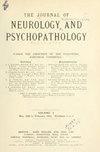Associated Facial, Vocal and Respiratory Components of Emotional Expression: An Experimental Study.
引用次数: 197
Abstract
AMONG the topics which Kinnier Wilson 1 has selected as representing some modern problems in neurology is that presented by the clinical picture of dissociation of the voluntary and emotional innervation of the facial muscles. It has long been known that patients suffering a paralysis of volitional movement of the facial musculature, as a result of supranuclear cortical or capsular lesions, may retain an activity of these muscles in the expression of emotion. Conversely, cases have been reported in which voluntary activation of the facial muscles has been unimpaired, while emotional excitement failed to produce the appropriate facial expression. In his review of this subject, Kinnier Wilson 2 has suggested in explanation that the voluntary and emotional innervations of the facial nuclei are effected by different systems within the brain. Enlarging upon this suggestion, Wilson has postulated a brainstem mechanism which subserves the synkinesis of the facial, vocal and respiratory activity observed in emotional behaviour. Further elucidation has been provided by Bard 3 in a consideration of facial and vocal activity from the point of view of his 4' 5 recent studies of the brainstem mechanisms involved in the expression of emotion. Our interest in this problem has developed from a series of investigations of these brainstem mechanisms (Ranson et al.6-13), in the course of which we have repeatedly observed coordinated facial and vocal responses obtained as specific reactions to stimulation of localized areas within the brainstem of experimental animals. It seemed desirable to make a special study of these effects, and we wish now to report the results of an investigation of such responses obtained from systematic electrical stimulation of the brainstem of the lightly anaesthetized cat and monkey and of the acutely decerebrate cat. METHODS情绪表达的相关面部、声音和呼吸成分:一项实验研究。
本文章由计算机程序翻译,如有差异,请以英文原文为准。
求助全文
约1分钟内获得全文
求助全文

 求助内容:
求助内容: 应助结果提醒方式:
应助结果提醒方式:


